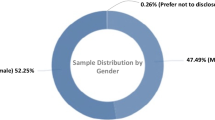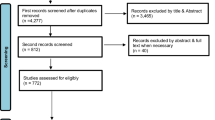Abstract
World Wide Web (WWW) “home pages” are now ubiquitous for universities around the world. A university home page is the first place that many stakeholders will visit for research on the university or for information on a variety of topics. It was hypothesised that the size and nature of universities and their investment in the staffing of WWW sites will determine the level of output of WWW sites. A WWW-based survey was conducted of Webmanagers at all universities in Australia. A response rate of 80% was achieved. The number of services provided, the number of pages made available and the number of pages that are changed on a regular basis were alternative measures of output. The hypothesised relationships were not supported. The study found that universities are providing a wide range of services with low levels of staffing.
Similar content being viewed by others
References
Callum, R. (1996) Spinning the Web: The Design of Yale's Front Door. CAUSE/EFFECT, 19(3), pp 49-51.
CAUSE. (1997) Current Issues for Higher Education Information Resources Management. CAUSE/EFFECT, 20 (1), pp. 4-7.
Cunningham, S., Tapsall, S., Ryan, Y., Stedman, L., Bagdon, K., and Flew, T. (1998). New Media and Borderless Education: A Review of the Convergence between Global Media Networks and Higher Education Provision (97/22). Canberra: Higher Education Division, Department of Employment, Education and Training.
Debreceny, R., and Ellis, A. (1998) Managing Student Access to University Information Networks-The Australian Experience. Campus-Wide Information Systems, 15(2), pp. 48-53.
Debreceny, R., and Ellis, A. (1997) The Management of Central World Wide Web Resources in Australian Universities. In R. Kevill, R. Oliver, and R. Phillips (Eds.), Proceedings of the 14th Annual Conference of the Australian Society for Computers in Learning in Tertiary Education (pp. 148-154). Perth, WA: Australian Society for Computers in Learning and Teaching (ASCILITE).
DEETYA. (1998) Selected Higher Education Student Statistics, 1997. Canberra: Department of Education, Employment and Training.
Ellis, A., and Debreceny, R. (1997a) Managing the Infrastructure for Telecommunications Based Education in Australia. In T. Müldner and T. C. Reeves (Eds.), Educational Multimedia and Hypermedia, 1997 and Educational Telecommunications, 1997 Proceedings of ED-MEDIA 97 and ED-TELECOM 97 (pp. 452-458). Calgary: Association for the Advancement of Computing in Education.
Ellis, A., and Debreceny, R. (1997b) The Webmanager-The Heart of University Web Sites: An Australian Perspective. Paper presented at the NAWEB97, St Johns.
Gladieux, L. E., and Swail, W. S. (1999). The Virtual University and Educational Opportunity-Issues of Equity and Access for the Next Generation. Washington DC: The College Board.
Goldenfarb, M. (1995) Critical Success Factors in Diffusing a Campus Wide Information System. In R. Debreceny and A. Ellis (Eds.), Innovation and Diversity-The World Wide Web in Australia. AusWeb95-Proceedings of the First Australian World WideWeb Conference (pp. 446-452). Lismore, NSW: Norsearch.
Hensarling, K. (1995) Campus Wide Information Systems: Moving From Prototype to Production. In R. Debreceny and A. Ellis (Eds.), Innovation and Diversity-The World Wide Web in Australia. AusWeb95-Proceedings of the First Australian World Wide Web Conference (pp. 405-409). Lismore, NSW: Norsearch.
McClure, P., Smith, J., and Sitko, T. (1997) The Crisis in Information Technology Support: Has Our Current Model Reached Its Limit? (Cause Professional Paper #16). Boulder, CO: Cause.
Meer, V., and Fravel, P. (1996) Enhancing University Administrators' Awareness of the Web: A Library Perspective. Computers in Libraries, 16(3), pp. 50-56.
Noam, E. (1995, 13 October) The future of the University. Science, 247.
Quinn, C. A. (1995). From Grass Roots to Corporate Image-The Maturation of the Web. CAUSE/EFFECT, 18(3), pp. 49-51.
RHEFP. (1998) Learning for Life: Final Report-Review of Higher Education Financing and Policy (6055HERE 98A). Canberra: Department of Employment, Education Training and Youth Affairs.
Ryan, E. A. (1996). Making the Most of the World Wide Web: How the Internet Is Helping Prospect Researchers Find New Information. Currents, 22(6), pp. 50-51.
Wilson, R. E., and Meadows, C. J. (1998). Tele-teaching: Australia's competitive question. Journal of Global Information Management, 6(1), pp. 15-26.
Author information
Authors and Affiliations
Rights and permissions
About this article
Cite this article
Debreceny, R., Ellis, A. The Production of World Wide Web Multimedia Resources by Australian Universities – An Institutional Analysis. Education and Information Technologies 5, 7–18 (2000). https://doi.org/10.1023/A:1009684300888
Issue Date:
DOI: https://doi.org/10.1023/A:1009684300888




